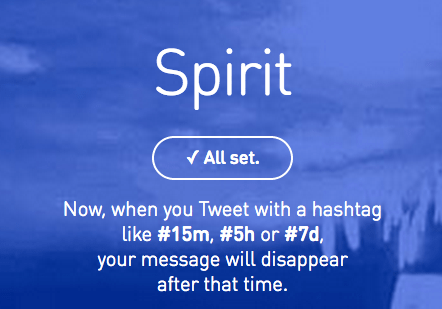Twitter is working on ways of getting more juice out of its vast trove of user content — that new “blue line” for conversation threads, for example, is a way for older conversations to resurface — so I don’t know how it is going to feel about this: a developer called Pierre Legrain, once himself a member of the Flock, has come up with Twitterspirit, a service that lets users set an expiration time for their tweets with a simple hashtag. Think of it as a Snapchat for Twitter, complete with its own emphemeral imagery (for Snapchat’s cute ghost, substitute an equally hard-to-pin-down spirit).
At a time when our data appears to be slipping out of our direct control, Snapchat has grabbed headlines for offering consumers a way of sending each other messages that disappear after a period of time. Twitter, of course, already lets users delete tweets. The difference with Twitterspirit is that this gives users more control over how long they would like their tweet to live — you set it with a #1m or #6h or #2y, and move on with your life.

Poof!

It follows other services that have also used hashtags to trigger the disappearance of a tweet — specifically, Efemr, which also uses an abbreviated number/letter to count down the timing. Legrain wouldn’t comment on Efemr when I asked him about what is different between the two services, but he did say that, in a general sense, “Long-term, I’m excited about ‘invisible software’ (no download, no installation, no interface), and adding additional custom functionality to Tweets.”
This is a fun little hack, but when you think about it, there are some more serious implications here.
Here’s one of the cons as I can see it: If part of Twitter’s business model is based on the data users put into it — for example, offering it as a measure of sentiment analysis for brands, or for brands to prove how well their promotions travel through the Twittersphere — then services that encourage people to delete what they’ve tweeted runs directly counter to that.
And considering the background of Twitterspirit’s creator, it’s a little bit cheeky, too. At his time at Twitter, Legrain, according to his LinkedIn profile, was a product marketing manager overseeing revenue. In the time he spent there between June 2010 and April 2011, he “launched Promoted Tweets, Promoted Trends, Promoted Accounts and Analytics,” and he says he “also conceived, designed, wrote and developed http://business.twitter.com.”
His other past experience included time with advertising giant WPP.
As for the pros, for one, messaging may disappear on ephemeral services, but that doesn’t mean that money does. When Snapchat raised $80 million at an $800 million valuation for its service, its co-founder told us that advertising and in-app purchases will be two key ways that it will make money. Having a similar tweak available for Twitter could also be gamed by brands for their own ends.
Legrain himself calls Twitterspirit is a “side project.”
“The impetus was to learn Python, PostgreSQL, Redis and Twitter’s API,” he told me in an email. He’s working on something else at the same time that is completely unrelated. He points out that since the launch, he’s come up with a couple of other applications of the service: adding Spirit tags to check-ins and other location-based tweets. You’re only at that restaurant for an hour, for an example. The other involves weather. Putting these tags into tweets could help meteorologists stay on top of developing weather patterns, ensuring that no longer accurate tweets get spread around.
It will be interesting to see how Twitterspirit fares with users on Twitter and whether it will be allowed to stay, or whether it, like those hashtagged and timed messages it helps you tag, disappears into thin air.
